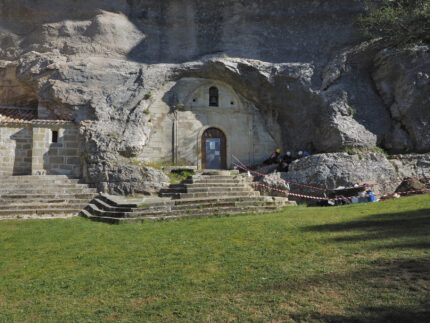Archaeologists have excavated a Hispano-Visigothic tomb in embedded in the rock next to the cave hermitage of San Tirso and San Bernabé in Burgos, northern Spain. A team from the Centro Nacional de Investigación sobre la Evolución Humana (CENIEH) unearthed the skeletal remains of an adult in a limestone slab tomb that dates to the late 7th, early 8th century. This discovery pushes back the evidence of the site’s use for Christian worship by centuries.
The anthropological studies, especially the analyses of stable isotopes of hydrogen, carbon and strontium, together with the dating for the remains, offer us a glimpse into the life of this person, who could have been associated with the first hermits who sought a retreat in this idyllic setting where they could live in isolation, during centuries of great turbulence linked to the arrival of the Moors, just as was the case elsewhere close to the upper course of the River Ebro and its tributaries in the south of the province of Cantabria, the north of Burgos, Álava and La Rioja.
The hermitage was built into the caves of the karst complex of Ojo Guareña, a network of 400 caves and 70 miles of galleries eroded out of the rock by the Trema and Guareña rivers. Humans have left their marks on the caves since the Middle Paleolithic. The earliest evidence of human usage are lithic from flint knapping about 70,000 years ago. There is cave art created as far back as 10,000 years through the beginning of the Bronze Age.
The cave chapel that is now dedicated to Christian saints Tirso and Bernabé was built at the site of a much earlier pagan sanctuary. The dates of construction are unknown. The first hermitage was dedicated to Saint Tirso, possibly as early as the 9th century, more likely the 13th. By the 18th century the hermitage was dedicated to a second saint, Bernabé, and between 1705 and 1877, the natural vaulted ceiling of the cave was painted with brightly colored murals depicting the miracles and martydoms of the saints.
Once the excavation has concluded and the human remains have been recovered, these will be consolidated and restored at the CENIEH. They will subsequently be subjected to dating, morphometric and paleopathological studies, while Ana Belén Marín and Borja González, researchers from the EvoAdapta R+D+i Group at the Universidad de Cantabria, will participate in isotopic studies.
source http://www.thehistoryblog.com/archives/62258










0 comments:
Post a Comment